Donation to Baseball Hall of Fame fulfills dream
Posted on April 26, 2012
One of my all-time favorite Giants, John Tamargo, has a print file in the photo archive at the National Baseball Hall of Fame and Museum in Cooperstown, New York (Photo by Brad Mangin)
I have been photographing Major League Baseball games for 25 years, dating back to 1987 when I was shooting beautiful Fujichrome slide film as a college intern at the Contra Costa Times. Over that time I have accumulated hundreds of thousands of baseball pictures, both on film and digital. I shot film through the 2002 season and started shooting digital in 2003. I love my pictures, and my online archive of over 50,000 baseball images generates regular income for me every month. I have many original transparencies I do not need anymore, and I would like to share my archive with someone who cares about baseball as much as I do. Enter the National Baseball Hall of Fame and Museum in Cooperstown, New York. This is the new home of many of my prized images.
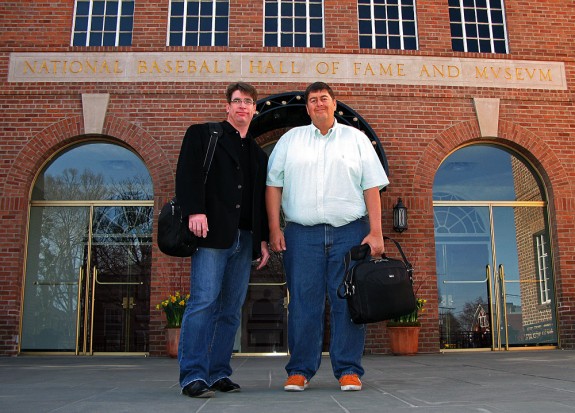
Robert Seale and Brad Mangin pose in front of the National Baseball Hall of Fame and Museum in Cooperstown, New York before lecturing about baseball photography on April 17, 2009. (Photo by Karen Warren)
Way back in 2002 my good friend and former picture editor at Major League baseball Photos, Paul Cunningham suggested that I donate some of my surplus slides to the Hall of Fame. Paul, raised in Cooperstown, told me that it was the job of the Hall of Fame to preserve the history of the game. After spending many months culling through thousands of pages of slides I finally sent 1,911 original chromes to the Hall of Fame’s Photo Archivist Pat Kelly. This donation made me feel good, and it also thrilled the Hall of Fame. I promised myself and Pat that I would be making more donations in the future. I had no idea it would take me another 10 years.
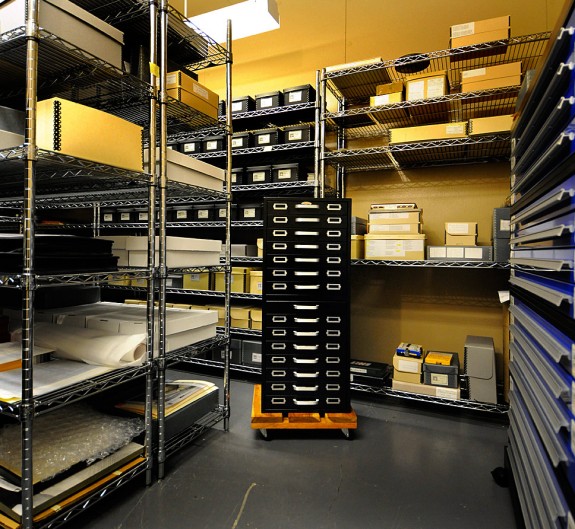
This special file cabinet houses the Brad Mangin collection of over 4,000 original color transparencies in cold storage at the National Baseball Hall of Fame and Museum in Cooperstown, New York. (Photo by Milo Stewart Jr. / National Baseball Hall of Fame Library)
The Hall of Fame is one of the coolest places on Earth. It is run by a wonderful group of people who love the game of baseball, led by President Jeff Idelson. I first met Jeff at the 2001 World Series at old Yankee Stadium and have had the pleasure of getting to know him over the years. The museum that Jeff runs is not affiliated with Major League Baseball. It is run independently and is not subject to corporate structure that can really wear down a photographer like me. They love their baseball in Cooperstown, and they really put a value on photography. As the past decade progressed I became more and more of a fan of the Hall of Fame, even though I had never been there. That changed in 2009.
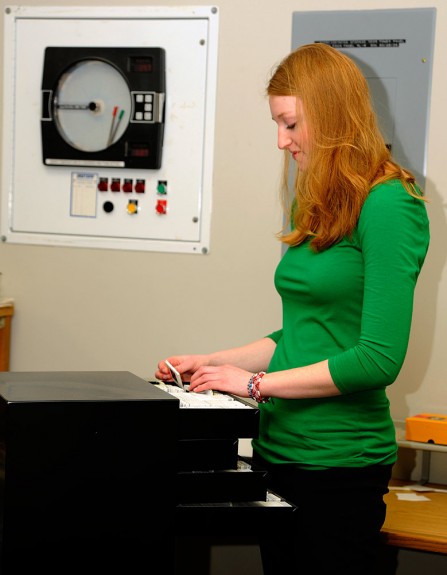
Hall of Fame intern Kelly Cleaver pulls slides from the Brad Mangin collection in cold storage at the National Baseball Hall of Fame and Museum in Cooperstown, New York. (Photo by Milo Stewart Jr. / National Baseball Hall of Fame Library)
Jeff invited fellow baseball fan and amazing Houston-based photographer Robert Seale and myself to speak about baseball photography at the Museum in April of 2009. We had a blast delivering several different lectures during our visit, and were treated like royalty as we were given VIP access to everything in the museum. We were even given the “white glove tour” of all the amazing artifacts in storage in the Museum’s basement.
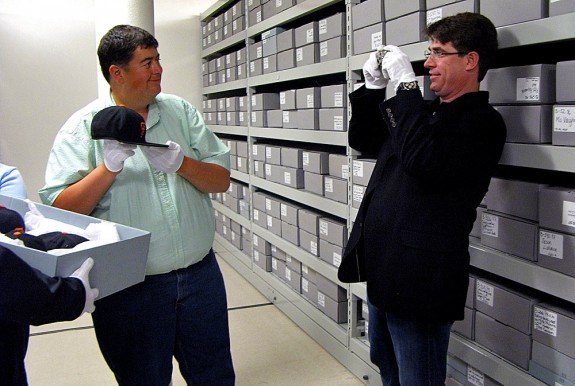
Robert Seale, right, photographs Brad Mangin holding the hat San Francisco Giants pitcher Ed Halicki wore when he threw a no-hitter against the New York Mets at Candlestick Park in San Francisco in 1975. Seale and Mangin are in the basement of the National Baseball Hall of Fame and Museum in Cooperstown, New York getting the white glove tour. (Photo by Karen Warren)
During my visit to Cooperstown I also met Assistant Photo Archivist Jenny Ambrose. Jenny showed us around the photo library, and while looking in the cold storage area I saw a some binders holding the slides I donated in 2002. It made me feel so good to see how they were caring for my pictures. This clinched it for me. I needed to make another donation- and soon!
I was further motivated to do something good with my images in 2010 when Bay Area photographer and former portrait artist for the Topps card company Doug McWilliams made a wonderful donation to the Hall of Fame by driving his valuable originals across the country with his son to make sure they made it into Pat Kelly’s hands safely. Doug is a terrific guy who I love seeing at the ballpark in Oakland a few times each year. Doug is also a baseball historian who began his career as a baseball photographer when he was 12-years-old by shooting pictures of Pacific Coast League games in the Oakland Oaks home ballpark in Emeryville during the 1950. Doug’s beautiful color portraits shot during spring training in Arizona and the regular season in Oakland and San Francisco during the 1970’s is a gold mine of history. I was so proud of Doug’s donation. I needed to keep up the Bay Area tradition and do more for the Museum.

It was pretty cool to get this certificate from the Hall of Fame after my recent donation, especially since it is signed by my friend Jeff Idelson.
I finally got my act together this past winter and sent Pat Kelly a FEDEX box filled with 2,386 original slides as a donation. This made my total donation of slides at over 4,000. This collection contains images from the late 1980’s through 2002. This made me feel good, but it was incomplete. The Hall of Fame also needs pictures of current players, and since no one shoots film anymore there are no slides to donate from anything that happened after 2002. Because my online searchable archive is so organized I did the next best thing. I gave Pat and Jenny total access to download any image they want for the Museum’s needs. That means they can peruse my online collection of 50,000 baseball images that is powered by the wonderful folks at PhotoShelter. The best part of this donation is that it grows each day I shoot a ballgame, allowing them to have access to the freshest images I shoot of the newest stars of the game. After shooting yesterday’s White Sox and A’s game in Oakland I uploaded 172 images that can be used immediately.
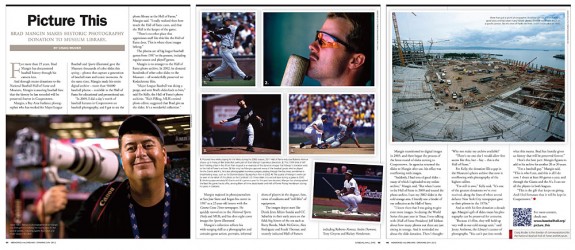
“Memories and Dreams,” the official magazine of The National Baseball Hall of Fame and Museum recently published a story about my donation. To download a PDF file of the three-page story and read it please click on the image above.
My feeling that there was no better place than the Museum for my images to live forever was reinforced when Jenny emailed me pictures of the brand-new filing cabinet that is used exclusively to hold my collection of slides in cold storage. I asked Jenny to explain the storage details and she graciously shared the following information with me.
“The slides stand upright in the cabinet. They are arranged alphabetically by the player’s surname, and then by subject for non-player images. Kelly Cleaver (our Hartwick College intern) created labels for all the slides giving the player’s full name and the accession number (a unique identifier). The three most important elements in preservation are light, temperature, and humidity. Your slides are stored in a steel cabinet with a baked-enamel finish. We keep them in a cold storage unit designed for film where we maintain a stable climate with a temperature of 42 degrees and a relative humidity of 30%. The unit is completely dark except when the staff is in the unit. The cabinet provides additional protection from light exposure. Cold storage helps prevent the deterioration of both the film base and the color dyes. In these conditions, preservation researchers have estimated the slides can be maintained for hundreds of years before there is significant deterioration or image fading.
We have chosen not to use plastic sleeves for our slide collections because the collection is constantly growing and the drawers make adding to the collection easier. There are archival-quality sleeves that are perfectly acceptable for slide storage. We always look for housing materials that pass the PAT (Photographic Activity Test), a worldwide standard for archival-quality photographic enclosures established by the Image Permanence Institute. The plasticized PVC used in the manufacture of many commercial slide pages may deteriorate, enabling the plasticizers to separate out. This can produce oily substances that can transfer to the slides and damaging gases. Buyer beware. The extra cost for archival quality is well worth it.
If you’d like to refer others to more information about photographic preservation, the Image Permanence Institute has many wonderful publications about the storage of slides and digital prints that might be useful to other photographers. Most of these are available to download for free at: https://www.imagepermanenceinstitute.org/resources/publications#color”
As I head out to the ballpark each day this season I can feel good that not only am I shooting for myself, I am also shooting to preserve the history of the game I love, the best way I know how. I am also shooting for the Hall of Fame! All of us photographers are recording history in our own way. I am thrilled that I have found a home for my historical images.
You can download a PDF file of the recent three-page story about my donation in “Memories and Dreams,” the official magazine of The National Baseball Hall of Fame and Museum, by clicking on this link.





Pingback: Hall of Fame visit was classic - Mangin Photography Archive